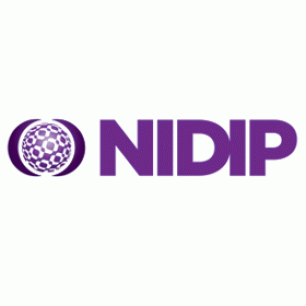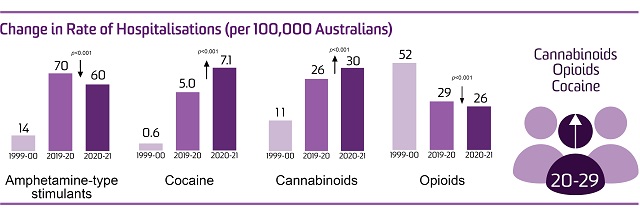There were 62,486 drug-related hospitalisations (excluding alcohol and tobacco) among Australians in 2020-21, according to a new report released today by the Drug Trends program at the National Drug and Alcohol Research Centre (NDARC), UNSW Sydney.
This equates to:
- 171 drug-related hospitalisations per day
- 255 drug related hospitalisations per 100,000 Australians
- 0.53 per cent of all hospitalisations in Australia
Drug Type
The largest proportion of drug-related hospitalisations in 2020-21 was attributable to amphetamine-type stimulants (23 per cent), followed by antiepileptic, sedative-hypnotic and antiparkinsonism drugs (e.g., benzodiazepines; 16 per cent), non-opioid analgesics (e.g., paracetamol, 13 per cent), cannabinoids (12 per cent) and opioids (11 per cent).
Key findings:
- Amphetamine-type stimulant-related hospitalisations dropped in 2020-21 after a sixfold increase between 2009-10 and 2019-20.
- The rate of cocaine-related hospitalisations has been low but increasing over time, with the biggest increase recorded in young adults aged 20-29 years.
- From 1999-00 to 2020-21, cannabinoid-related hospitalisations increased nearly three-fold from 11 to 30 per 100,000 people. There was an increase observed in the rate of cannabinoid-related hospitalisations among young females, particularly those aged 20-29 years.
- A decrease in the rate of opioid-related hospitalisations has been observed since 2016-17.
COVID-19
The COVID-19 pandemic and associated restrictions impacted drug supply and demand and there has been concern around related changes in drug-related harms in Australia.
Key findings:
- Analyses in this report show that the rate of drug-related hospitalisations nationally was higher in the third and fourth quarter of 2020, compared to the first quarter of 2020 (prior to the onset of COVID-19).
These comparisons should be treated with caution as there are other factors which may contribute to the shifts observed, and more sophisticated analyses over a longer period are required.
Sex, age and location
The population rate of drug-related hospitalisations has been relatively stable in the last three years with 251 hospitalisations per 100,000 people in 2018-19, 253 in 2019-20 and 255 in 2020-21.
Key findings:
- In 2020-21, males and females had a similar rate of drug-related hospitalisations. This was after an increase in the rate of drug-related hospitalisations among females and a decrease among males in the past year.
- In 2020-21, the highest rates of drug-related hospitalisations continued to be observed among the 20-29 and the 30-39 age groups.
- The greatest increase in rate was recorded in the youngest 10-19 age group (from 251 hospitalisations per 100,000 people in 2019-20 to 302 in 2020-21), largely driven by a significant increase in drug-related hospitalisations among females in this age group.
- From 2019-20 to 2020-21, there was a significant increase in the population rate of drug-related hospitalisations in major city areas and a significant decrease in rate in inner and outer regional areas.
What is a drug-related hospitalisation?
- A hospitalisation in this report (also called hospital separation) refers to a completed episode of admitted patient’s care in a hospital ending with discharge, death, transfer or a portion of a hospital stay beginning or ending in a change to another type of care.
- A drug-related hospitalisation refers to a hospitalisation where the principal diagnosis indicates a substance use disorder or direct harm due to selected substances.
About the report
Trends in drug-related hospitalisations in Australia, 1999-2021 reports on drug-related hospitalisations with a particular focus on opioid, amphetamine and other stimulant, cannabinoid, and cocaine-related hospitalisations, using data extracted from the National Hospital Morbidity Database held by the Australian Institute of Health and Welfare (AIHW).
The full report is available on the NDARC website.
About Drug Trends
The Drug Trends program has been coordinated by NDARC since 1996 with funding from the Australian Government Department of Health and Aged Care.
It is undertaken in partnership with researchers from National Drug Research Institute, Curtin University; Burnet Institute; School of Psychology, University of Tasmania; and Institute for Social Science Research, University of Queensland.
The Drug Trends program is key to identifying emerging problems in substance use in Australia. Read more.






